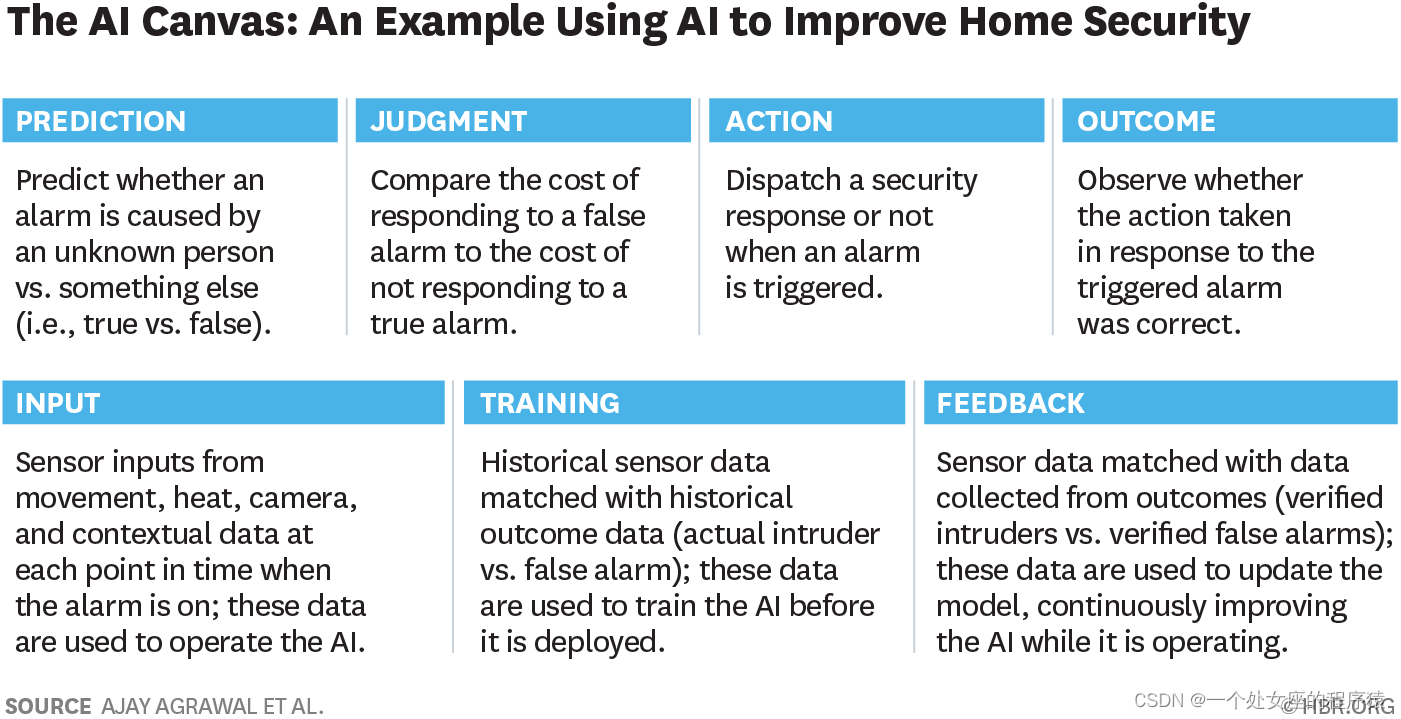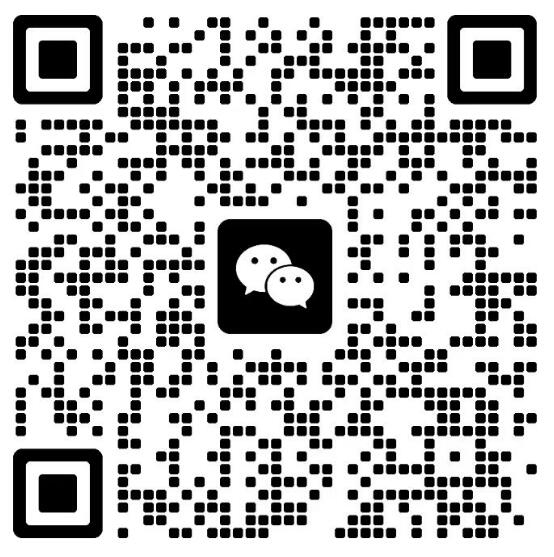AI:《A Simple Tool to Start Making Decisions with the Help of AI—借助人工智能开始决策的简单工具》翻译与解读
AI:《A Simple Tool to Start Making Decisions with the Help of AI—借助人工智能开始决策的简单工具》翻译与解读
目录
《A Simple Tool to Start Making Decisions with the Help of AI》翻译与解读
思考 Al 如何帮助做出业务决策—The Al Canvas
AI Canvas如何工作—利用人工智能解决家庭安全警报案例
PREDICTION→JUDGMENT→ACTION→OUTCOME
《A Simple Tool to Start Making Decisions with the Help of AI》翻译与解读
作者:Ajay Agrawal, Joshua Gans和Avi Goldfarb
文章地址:A Simple Tool to Start Making Decisions with the Help of AI
发布平台:Analytics And Data Science
发布时间:2018年4月17日
Summary
| Recent developments in AI are about lowering the cost of prediction. Better predictions matter when you make decisions in the face of uncertainty, as every business does, constantly. But how do you think through what it would take to incorporate a prediction machine into your decision-making process? In teaching this subject to MBA graduates at the University of Toronto’s Rotman School of Management, the authors have introduced a simple decision-making tool: the AI Canvas. Each space on the canvas contains one of the requirements for machine-assisted decision making, beginning with a prediction. To explain how the AI Canvas works, the authors use an example crafted during one of their AI strategy workshops: home security. | 人工智能最新的发展是关于降低预测成本。当你在面对不确定性时做出决策时,更好的预测很重要,就像每个企业都在不断地做的那样。但是,你如何考虑将预测机器整合到你的决策过程中需要做些什么?在多伦多大学(University of Toronto)罗特曼管理学院(Rotman School of Management)向MBA毕业生讲授这一主题时,两位作者介绍了一种简单的决策工具:人工智能画布(AI Canvas)。画布上的每个空间都包含机器辅助决策的一个要求,从预测开始。为了解释AI Canvas是如何工作的,作者使用了一个在AI战略研讨会上制作的例子:家庭安全。 |
思考 Al 如何帮助做出业务决策—The Al Canvas
| There is no shortage of hot takes regarding the significant impact that artificial intelligence (AI) is going to have on business in the near future. Much less has been written about how, exactly, companies should get started with it. In our research and in our book, we begin by distilling AI down to its very simplest economics, and we offer one approach to taking that first step. We start with a simple insight: Recent developments in AI are about lowering the cost of prediction. AI makes prediction better, faster, and cheaper. Not only can you more easily predict the future (What’s the weather going to be like next week?), but you can also predict the present (what is the English translation of this Spanish website?). Prediction is about using information you have to generate information you don’t have. Anywhere you have lots of information (data) and want to filter, squeeze, or sort it into insights that will facilitate decision making, prediction will help get that done. And now machines can do it. Better predictions matter when you make decisions in the face of uncertainty, as every business does, constantly. But how do you think through what it would take to incorporate a prediction machine into your decision-making process? In teaching this subject to MBA graduates at the University of Toronto’s Rotman School of Management, we have introduced a simple decision-making tool: the AI Canvas. Each space on the canvas contains one of the requirements for machine-assisted decision making, beginning with a prediction. | 关于人工智能(AI)在不久的将来将对商业产生的重大影响,热门话题层出不穷。关于公司应该如何开始使用它的文章却少得多。在我们的研究和书中,我们首先将人工智能提炼为最简单的经济学原理,并提供了迈出第一步的方法。 我们从一个简单的观点开始:人工智能最近的发展是关于降低预测成本。人工智能使预测变得更好、更快、更便宜。你不仅可以更容易地预测未来(下周天气怎么样?),而且你也可以预测现在(这个西班牙语网站的英文翻译是什么?)预测就是利用你拥有的信息来生成你没有的信息。当你有大量的信息(数据)并想要过滤、压缩或分类成有助于决策制定的见解时,预测将有助于完成这项工作。现在机器可以做到了。 当你在面对不确定性时做出决定时,更好的预测很重要,就像每个企业都在不断地做的那样。但是,你如何考虑将预测机器整合到你的决策过程中需要做些什么? 在多伦多大学(University of Toronto)罗特曼管理学院(Rotman School of Management)向MBA毕业生讲授这一课程时,我们引入了一种简单的决策工具:人工智能画布(AI Canvas)。画布上的每个空间都包含机器辅助决策的一个要求,从预测开始。 |


| Use it to think through how Al could help with business decisions. 用它来思考 Al 如何帮助做出业务决策。 | The Al Canvas: An Example using Al to Improve Home Security Al Canvas:一个使用Al改善家庭安全的例子 | |
| PREDICTION | What do you need to know to make the decision? 你需要知道什么才能做出决定? | Predict whether an alarm is caused by an unknown person vs. something else (i.e.,true vs. false). 预测警报是由陌生人还是其他东西引起的(即真还是假)。 |
| JUDGMENT | How do you value different outcomes and errors? 你如何评价不同的结果和错误? | Compare the cost of responding to a false alarm to the cost of not responding to a true alarm. 比较响应虚假警报的成本与不响应真实警报的成本。 |
| ACTION | What are you trying to do? 你想做什么? | Dispatch a security response or not when an alarm is triggered. 触发警报时是否发送安全响应。 |
| OUTCOME | What are your metrics for task success? 你衡量任务成功的标准是什么? | Observe whether the action taken in response to the triggered alarm was correct. 观察针对触发警报所采取的措施是否正确。 |
| INPUT | What data do you need to run the predictive algorithm? 运行预测算法需要什么样的数据? | Sensor in puts from movement, heat, camera, and contextual data at each point in time when the alarm is on;these data are used to operate the Al. 传感器输入从运动,热量,摄像机和上下文数据在每个时间点的警报,这些数据用于操作Al。 |
| TRAINING | What data do you need to train the predictive algorithm? 训练预测算法需要哪些数据? | Historical sensor data matched with historical outcome data(actual intruder vs. false alarm);these data are used to train the Al before deployed. 历史传感器数据与历史结果数据相匹配(实际入侵者vs.误报);这些数据用于在部署之前训练 AI。 |
| FEEDBACK | How can you use the outcomes to improve the algorithm? 如何使用结果来改进算法? | Sensor data matched with data collected from outcomes (verified intruders vs. verified false alarms); these data are used to update the model,continuously improving the Al while it is operating. 传感器数据与从结果中收集的数据相匹配(经过验证的入侵者vs.经过验证的误报);利用这些数据对模型进行更新,在模型运行过程中不断改进AI。 |
AI Canvas如何工作—利用人工智能解决家庭安全警报案例
| To explain how the AI Canvas works, we’ll use an example crafted during one of our AI strategy workshops by Craig Campbell, CEO of Peloton Innovations, a venture tackling the security industry with AI. (It’s a real example, based on a product that Peloton is commercializing, called RSPNDR.ai.) Over 97% of the time that a home security alarm goes off, it’s a false alarm. That is, something other than an unknown intruder (threat) triggered it. This requires security companies to make a decision as to what to do: Dispatch police or a guard? Phone the homeowner? Ignore it? If the security company decides to take action, more than 90 out of 100 times, it will turn out that the action was wasted. However, always taking an action in response to an alarm signal means that when a threat is indeed present, the security company responds. How can you decide whether employing a prediction machine will improve matters? The AI Canvas is a simple tool that helps you organize what you need to know into seven categories in order to systematically make that assessment. We provide an example for the security alarm case. | 为了解释AI Canvas是如何工作的,我们将使用一个由Peloton Innovations首席执行官Craig Campbell在人工智能战略研讨会上制作的例子,该公司是一家利用人工智能解决安全行业问题的企业。(这是一个真实的例子,它基于Peloton正在商业化的一款名为RSPNDR.ai的产品。) 超超过 97% 的家庭安全警报响起是误报。也就是说,不是未知的入侵者(威胁)触发了它。这就需要安保公司做出决定:派遣警察还是警卫?给房主打电话吗?忽略它吗?如果安保公司决定采取行动,100次中有90次以上,结果是行动白白浪费了。然而,总是对警报信号采取行动意味着当威胁确实存在时,安全公司会做出反应。 你如何决定使用预测机器是否会改善情况?AI Canvas是一个简单的工具,它可以帮助你将你需要知道的内容组织成7个类别,以便系统地进行评估。本文以安防报警案例为例。 |
PREDICTION→JUDGMENT→ACTION→OUTCOME
| First, you specify what you are trying to predict. In the alarm case, you want to know whether an alarm is caused by an unknown person or not (true versus false alarm). A prediction machine can potentially tell you this — after all, an alarm with a simple movement sensor is already a sort of prediction machine. With machine learning, you can take a richer range of sensor inputs to determine what you really want to predict: whether the movement was caused specifically by an unknown person. With the right sensors — say, a camera in the home to identify known faces or pets, a door key that recognizes when someone is present, and so on — today’s AI techniques can provide a more nuanced prediction. The prediction is no longer “movement = alarm” but, for example, “movement + unrecognized face = alarm.” This more sophisticated prediction reduces the number of false alarms, making the decision to send a response, as opposed to trying to contact the owner first, an easier one. | 首先,您指定您试图要预测的内容。在警报的情况下,您想知道警报是否由未知人员引起的(真警报与假警报)。一个预测机器可能会告诉你这一点——毕竟,一个带有简单运动传感器的警报已经是一种预测机器了。通过机器学习,您可以采用更丰富的传感器输入来确定您真正想要预测的内容:运动是否是由不未知的人专门引起的。有了合适的传感器——比如,在家里安装一个可以识别已知面孔或宠物的摄像头,一把可以识别某人何时在场的门钥匙等等——今天的人工智能技术可以提供更细微的预测。预测不再是“运动=警报”,而是,例如,“运动+无法识别的面孔=警报”。这种更复杂的预测减少了误报的数量,使发送响应的决定比尝试首先联系所有者更容易。 |
| No prediction is 100% accurate. So, in order to determine the value of investing in better prediction, you need to know the cost of a false alarm, as compared with the cost of dismissing an alarm when it is true. This will depend on the situation and requires human judgment. How costly is a response phone call to verify what is happening? How expensive is it to dispatch a security guard in response to an alarm? How much is it worth to respond quickly? How costly is it to not respond if it turns out that there was an intruder in the home? There are many factors to consider; determining their relative weights requires judgment. | 没有预测是100%准确的。因此,为了确定投资于更好的预测的价值,您需要知道误报的成本,以及在警报为真时解除警报的成本相比。这将取决于情况并需要人为判断。一个验证正在发生的事情的响应电话的成本是多少?在接到警报后派遣一名保安要花多少钱?快速响应值多少钱?如果事实证明家里有入侵者,不回应的代价有多大?有很多因素需要考虑;确定它们的相对权重需要判断。 |
| Such judgment can change the nature of the prediction machine you deploy. In the alarm case, having cameras all over the house may be the best way of determining the presence of an unknown intruder. But many people will be uncomfortable with this. Some people would prefer to trade the cost of dealing with more false alarms for enhanced privacy. Judgment sometimes requires determining the relative value of factors that are difficult to quantify and thus compare. While the cost of false alarms may be easy to quantify, the value of privacy is not. Next, you identify the action that is dependent on the predictions generated. This may be a simple “dispatch/don’t dispatch” decision, or it may be more nuanced. Perhaps the options for action include not just dispatching someone but also enabling immediate remote monitoring of who is in the home or some form of contact with the home owner. | 这种判断可以改变您部署的预测机器的性质。在报警的情况下,在房子里到处安装摄像头可能是确定未知入侵者存在的最好方法。但是很多人会对此感到不舒服。有些人宁愿用处理更多误报的成本来换取增强的隐私。判断有时需要确定难以量化和比较的因素的相对价值。虽然误报的成本可能很容易量化,但隐私的价值却并非如此。 接下来,您将识别依赖于生成的预测的操作。这可能是一个简单的“派遣/不派遣”决定,或者可能更细微。也许行动的选择不仅包括派遣人员,还包括即时远程监控谁在家中,或与房主进行某种形式的联系。 |
| An action leads to an outcome. For example, the security company dispatched a security guard (action), and the guard discovered an intruder (outcome). In other words, looking back, we are able to see for each decision whether the right response occurred. Knowing this is important for evaluating whether there is scope to improve predictions over time. If you do not know what outcome you want, improvement is difficult, if not impossible. | 一个行动导致一个结果。例如,保安公司派遣了一个保安人员(动作),而该保安发现了一个入侵者(结果)。换句话说,回顾过去,我们能够看到每一个决定是否发生了正确的反应。了了解这一点对于评估随着时间的推移是否有改进预测的空间很重要。如果你不知道你想要什么结果,改进是困难的,如果不是不可能的话。 |
| The top row of the canvas — prediction, judgment, action, and outcome — describes the critical aspects of a decision. On the bottom row of the canvas are three final considerations. They all relate to data. To generate a useful prediction, you need to know what is going on at the time a decision needs to be made — in this case, when an alarm is triggered. In our example, this includes motion data and image data collected at the home in real time. That is your basic input data. | 画布的最上面一行——预测、判断、行动和结果——描述了决策的关键方面。在画布的最后一排是最后三个考虑因素。它们都与数据有关。为了生成有用的预测,您需要知道在需要做出决策时(在本例中是在触发警报时)发生了什么。在我们的例子中,这包括在家中实时收集的运动数据和图像数据。这是基本的输入数据。 |
INPUT→TRAINING→FEEDBACK
| But to develop the prediction machine in the first place, you need to train a machine learning model. Training data matches historical sensor data with prior outcomes to calibrate the algorithms at the heart of the prediction machine. In this case, imagine a giant spreadsheet where each row is a time the alarm went off, whether there was in fact an intruder, and a bunch of other data like time of day and location. The richer and more varied that training data, the better your predictions will be out of the gate. If that data is not available, then you might have to deploy a mediocre prediction machine and wait for it to improve over time. | 但是首先要开发预测机器,你需要训练一个机器学习模型。训练数据将历史传感器数据与之前的结果进行匹配,以校准预测机器的核心算法。在这种情况下,想象一个巨大的电子表格,其中每一行是警报响起的时间,是否真的有入侵者,以及一堆其他数据,如一天中的时间和位置。训练数据越丰富、越多样化,你的预测效果就越好。如果该数据不可用,那么您可能不得不部署一个普通的预测机器,并等待它随着时间的推移而改进。 |
| Those improvements come from feedback data. This is data that you collect when the prediction machine is operating in real situations. Feedback data is often generated from a richer set of environments than training data. In our example, you may correlate outcomes with data collected from sensors through windows, which affect how movements are detected and how cameras capture a facial image — perhaps more realistic than the data used for training. So, you can improve the accuracy of predictions further with continual training using feedback data. Sometimes feedback data will be tailored to an individual home. Other times, it might aggregate data from many homes. | 这些改进来自于反馈数据。这是预测机在真实情况下运行时所收集的数据。反馈数据通常是从比训练数据更丰富的环境中生成的。在我们的例子中,您可以将结果与通过窗户从传感器收集的数据相关联,这些数据影响着如何检测运动以及相机如何捕捉面部图像——可能比用于训练的数据更真实。因此,您可以通过使用反馈数据的持续训练进一步提高预测的准确性。有时反馈数据将针对个人家庭进行定制。其他时候,它可能会收集许多家庭的数据。 |
总结
| Clarifying these seven factors for each critical decision throughout your organization will help you get started on identifying opportunities for AIs to either reduce costs or enhance performance. Here we discussed a decision associated with a specific situation. To get started with AI, your challenge is to identify the key decisions in your organization where the outcome hinges on uncertainty. Filling out the AI Canvas won’t tell you whether you should make your own AI or buy one from a vendor, but it will help you clarify what the AI will contribute (the prediction), how it will interface with humans (judgment), how it will be used to influence decisions (action), how you will measure success (outcome), and the types of data that will be required to train, operate, and improve the AI. The potential is enormous. For example, alarms communicate predictions to a remote agent. Part of the reason for this approach is that there are so many false signals. But just think: If our prediction machine became so good that there were no false alarms, then is dispatch still the right response? One can imagine alternative responses, such as an on-site intruder capture system (as in cartoons!), which could be more feasible with significantly more-accurate and high-fidelity predictions. More generally, better predictions will create opportunities for entirely new ways to approach security, potentially predicting the intent of intruders before they even enter. | 明确整个组织中每个关键决策的这七个因素,将有助于您开始识别AI降低成本或提高性能的机会。这里我们讨论了一个与特定情况相关的决策。要开始使用AI,您面临的挑战是确定您的组织中的关键决策,而这些决策的结果取决于不确定性。填写AI Canvas上不会告诉你您是应该制作自己的 AI 还是从供应商处购买 AI,但它会帮助你阐明 AI 将做出什么贡献(预测),它将如何与人类交互(判断),它将如何用于影响决策(行动),如何衡量成功(结果),以及训练、操作和改进 AI 所需的数据类型。 潜力是巨大的。例如,警报将预测信息传递给远程代理。这种方法的部分原因是有太多的错误信号。但请想一想:如果我们的预测机器变得如此强大,以至于没有误报,那么调度仍然是正确的响应吗?可以想象另一种响应方式,比如现场入侵者捕获系统(就像卡通里的那样!),如果预测更加准确和高保真,这可能更可行。更一般地说,更更好的预测将为接近安全的全新方法创造机会,甚至可能在入侵者进入之前预测他们的意图。 |
致谢
| Ajay Agrawal is the Geoffrey Taber Chair in Entrepreneurship and Innovation at the University of Toronto’s Rotman School of Management. He is the founder of the Creative Destruction Lab, co-founder of The Next AI, and co-founder of Kindred. He is the co-author of Prediction Machines: The Simple Economics of Artificial Intelligence (Harvard Business Review Press, April 2018). Joshua Gans is the Jeffrey S. Skoll Chair in Technical Innovation and Entrepreneurship at the Rotman School of Management, University of Toronto, and the chief economist at the Creative Destruction Lab. He is the author of The Disruption Dilemma (MIT Press, March 2016) and a co-author of Prediction Machines: The Simple Economics of Artificial Intelligence (Harvard Business Review Press, April 2018). Avi Goldfarb is the Rotman Chair in Artificial Intelligence and Healthcare at the Rotman School of Management, University of Toronto. He is also the chief data scientist at the Creative Destruction Lab and the co-author of Prediction Machines: The Simple Economics of Artificial Intelligence (Harvard Business Review Press, April 2018). | Ajay Agrawal是多伦多大学罗特曼管理学院创业与创新领域的Geoffrey Taber主席。他是Creative Destruction Lab的创始人,The Next AI的联合创始人,以及Kindred的联合创始人。他是《预测机器:人工智能的简单经济学》(哈佛商业评论出版社,2018年4月)的合著者。 本文作者乔舒亚•甘斯是多伦多大学罗特曼管理学院(Rotman School of Management, University of Toronto)技术创新与创业杰弗里•s•斯科尔(Jeffrey S. Skoll)主席,同时也是创造性破坏实验室(Creative Destruction Lab)的首席经济学家。他是《颠覆困境》(the Disruption Dilemma)一书的作者(麻省理工学院出版社,2016年3月),《预测机器:人工智能的简单经济学》(Harvard Business Review Press, 2018年4月)的合著者。 阿维·戈德法布(Avi Goldfarb)是多伦多大学(University of Toronto)罗特曼管理学院(Rotman School of Management)人工智能和医疗保健领域的罗特曼主席。他还是创造性破坏实验室(Creative Destruction Lab)的首席数据科学家,《预测机器:人工智能的简单经济学》(Prediction Machines: the Simple Economics of Artificial Intelligence,哈佛商业评论出版社,2018年4月)的合著者。 |
网站声明:如果转载,请联系本站管理员。否则一切后果自行承担。
- 上周热门
- 如何使用 StarRocks 管理和优化数据湖中的数据? 2951
- 【软件正版化】软件正版化工作要点 2872
- 统信UOS试玩黑神话:悟空 2833
- 信刻光盘安全隔离与信息交换系统 2728
- 镜舟科技与中启乘数科技达成战略合作,共筑数据服务新生态 1261
- grub引导程序无法找到指定设备和分区 1226
- 华为全联接大会2024丨软通动力分论坛精彩议程抢先看! 165
- 2024海洋能源产业融合发展论坛暨博览会同期活动-海洋能源与数字化智能化论坛成功举办 163
- 点击报名 | 京东2025校招进校行程预告 163
- 华为纯血鸿蒙正式版9月底见!但Mate 70的内情还得接着挖... 159
- 本周热议
- 我的信创开放社区兼职赚钱历程 40
- 今天你签到了吗? 27
- 如何玩转信创开放社区—从小白进阶到专家 15
- 信创开放社区邀请他人注册的具体步骤如下 15
- 方德桌面操作系统 14
- 用抖音玩法闯信创开放社区——用平台宣传企业产品服务 13
- 我有15积分有什么用? 13
- 如何让你先人一步获得悬赏问题信息?(创作者必看) 12
- 2024中国信创产业发展大会暨中国信息科技创新与应用博览会 9
- 中央国家机关政府采购中心:应当将CPU、操作系统符合安全可靠测评要求纳入采购需求 8

